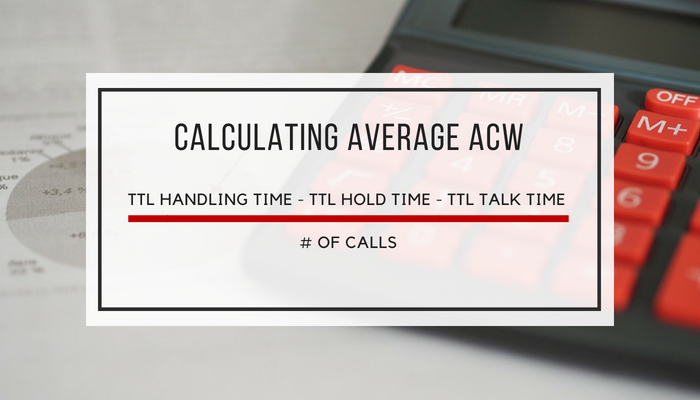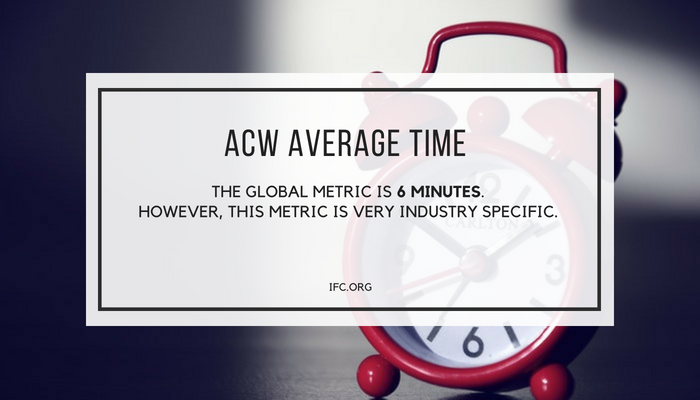Service Against the Clock
Call center agents are pressured to be efficient and provide customers with a positive service experience. Agents have a list of tasks that need to be completed both during and after every interaction. They also have to work within a time limit on just about every task. One of these tasks is done after an interaction is completed. It’s referred to as After Call Work. Take a look at this comment from a thread dedicated to After Call Work or ACW from the Reddit group r/talesfromcallcenters.
Don’t use After Call Work for after call work
“My job allows us 45 seconds of ACW. Meanwhile, if someone is calling in with like 5 different issues they all have to go under 5 different categories with detailed notes. So we have to keep track to keep our call under 6 1/2 minutes while keeping detailed notes (no abbreviations at all) and actually working on the reason why they called in to begin with. It’s very hard for me to type and talk at the same time. I jot notes down so I don’t forget why they are calling but I either start typing what I’m saying or saying what I’m typing! I’m a fast typist and can get my notes done pretty quickly but not in 45 seconds! Especially for multiple reasons for calling in.” jennabellie. Reddit. Reddit, Inc. Web. 2017.
The Work of After Call Work
The work after a call involves a long list of information like call purpose, customer concerns, and call outcome. ACW activities can also include sending follow-up emails and forwarding requests to a supervisor. It is often a long list of information that must be logged before the agent can pick up their next call. It’s an important KPI for call centers no matter if they are inbound, outbound or hybrid of both functions. Some call centers limit a support agent’s ACW time, some push their agents to have a majority of the call notes recorded during their calls. As is apparent from the Reddit comment above, these approaches have still their pitfalls.

Managing the Minutes
Managing ACW tasks can be solved by combining internally created resources and processes with technology tailored to a call center’s needs. These are some of the universally recommended internal strategies and tools for managing ACW:
- Make call text management practices a detailed part of your training process.
- Set up a mentor program by pairing seasoned agents with agents that are new or struggling with managing their after call work activities.
- Provide reusable repetitive call text that agents can cut and paste into their notes for common call issues.
- Allow the use of an approved list of call center abbreviations to help with completing notations while on a call.
- Create a bank of templates for emails responses for common issues.
- Build a resource library of responses for common live chat questions.
Lastly, one of the most useful internal strategies is to practice continuous quality improvement measures. Ask for feedback from your agents on the after call processes and resources currently in place and regularly after implementing any changes. This practice can help in identifying what is working and what isn’t.
Supercharging the Minutes
Working with your team can help curb the challenges agents face in managing their ACW tasks and time limitations. If you have this part of the equation figured out then it’s time to turn your attention to the technologies in place. CTI tools that work with your CRM will, among many other things, will provide more accurate customer records, call data and analytics on agent efficiency.
At the foundation of a good call center technical stack is a good CRM (customer relationship management), like Salesforce. The blocks that build upon this foundation are CTI (computer telephony integration) applications. Important information is centralized in one location, easily obtained from your CRM after every call.
For example:
- Call Tracking – Active call or even voicemail recordings can be automatically added to a customer case within your CRM and data entries can be programmed to populate a helpdesk ticket. CTI tools allow the syncing of data from phone calls to CRM and ticketing so call data doesn’t get siloed.
- Note-Taking – CTI tools allow agents to directly update a CRM with non-call customer interactions from emails and texts to social media.
The Domino Effect of Good ACW
Although ACW occurs after an agent has interacted with a customer, it is important that is well-executed as it contributes to a customer’s level of satisfaction and overall experience. The information recorded benefits the customer should they need to interact again with your organization.
There are customer cases that can require scheduling follow-up calls, consultations or service appointments. This is an opportunity to extend the quality of customer service that your call center provides. Rather than making it difficult for your customer to schedule a follow-up call or meeting, your agents can make it convenient for the customer by offering self-scheduling:
- Scheduled maintenance like software and equipment updates
- Email drip updates on renewals
- Schedule an appointment from a chat
- Incoming calls from customers to schedule initial consultation or service for a physical location
Self-scheduling is a convenience for both call centers and your customers. Customers value the ease of scheduling an appointment and are more apt to keep the appointment. And agents can spend more time on higher priority tasks rather than repeatedly calling or emailing a customer to set or reschedule an appointment.
Related resources: Invest in Your Call Center’s Success – Average Time in Queue
If you would like to consider appointment scheduling for your call center, SUMO Scheduler includes all the features discussed above. You can even make your own custom reports on any table or field in the database and have a report or collection of reports emailed to you every Monday AM before your management meeting. And as a Salesforce® native application, SUMO can extend the power of your Salesforce CRM and Service Cloud®.
SUMO extends the Service Cloud® with powerful scheduling features like:
- a host of powerful auto-assignment modes.
- Sending appointment invites from Salesforce to contacts from cases.
- Inviting contacts to schedule with you or a co-worker.
Not to mention, the ease of data management as everything is in Salesforce with no need to manage two sets of customer data. Let one of our scheduling experts show you how we can help your agents be more productive, deliver better service faster, and improve your organization’s C-SAT.





